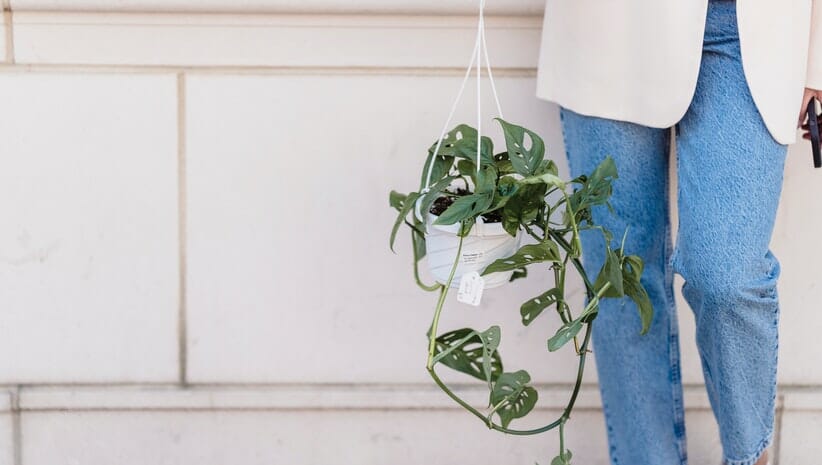
Benefits of Houseplants at Home and with Yoga Practice
Many people, myself included, are drawn to plants. Research shows that nature has restorative properties for the human psyche. The good news is you don’t need to look any further than the plant on your windowsill. But beyond this all-around general goodness of nature, more specifically, houseplants can elevate mindfulness practice by providing grounding and teaching us lessons on patience and acceptance.
When Plant Proper started their online plant shop in early 2020, they had no idea what was in store for their young business in the following months. By summer, Covid lockdowns created a surge in houseplant popularity as people turned to joyful hobbies during an otherwise grim time. Many shops were closed to the public, but online retailers like Plant Proper made it easy for prospective plant parents to shop safely for their favorite varieties.
Caring for a plant (or many) has allowed lots of people a taste of nature during stay-at-home orders, when public natural places may have restrictions in place. As the world starts to open back up, the same plants that comforted us during the pandemic can be a useful tool for re-navigating the stresses of everyday life.
Here are some ways that you can use plants to elevate your yoga and mindfulness practices and some helpful tips to get you started.
Ground Yourself in Nature
Grounding is a great mindfulness exercise to improve focus and reduce stress, and there’s no better way to practice than to experience something that grows from the ground. Some grounding techniques involve focusing on your body or thoughts, but here we’re going to discuss how to use an external object, your favorite new plant.
Plants both large and small offer a variety of sensory experiences to focus on when grounding, so no need to worry about picking the “wrong” kind. They’re all perfect!
Find a comfortable seat where you can observe your plant. Let your attention focus entirely on it, and bring your mind back if it wanders. Take in the plant’s qualities with as many senses as you can.
Here are some questions you can ask while observing to help you get started:
- What color are the leaves? Is there more than one color?
- What shape are the leaves? Are they thick or thin? How big are they? Are they smooth, rough, or fuzzy? Are they stiff or flexible?
- Does the plant have any flowers? What color are they? What do they smell like?
- When the wind blows, What sound does the plant make?
This is a great practice for whenever you get a new plant in order to get to know it. If you want to incorporate this kind of grounding regularly in your mindfulness practice, tie it in to your watering habit.

Slow Down and Connect with the Present
Do you ever feel like time slips out from under your feet? When our minds our disconnected from the present, our perception of time tends to lurch and drag. Tuning into our plants’ growth cycles can help enhance our perception of time and anchor our minds in the present.
Think of it like this. Plants grow at their own pace. Sure, we can help them out by offering water, sunlight, and fertilizer, but they won’t grow any faster just because we tell them to! Some plant species, like pothos, grow fast while others grow much slower (I’m looking at you, succulents).
As you tune in to your plants over time with a regular grounding practice, you’ll start to notice how their growth ties in with the seasons and time of year. By connecting with the present in this way, you can teach your mind to slow down.
In the same way, plants also teach patience. It’s easy to become discouraged by plants in the winter when their growth slows to a crawl, but you have to remain patient for the explosion of growth that will come in spring. Just like plants grow at their own pace, your body changes exactly as fast as it wants to. Remember this the next time you hit the mat and get frustrated about not being able to hold Crow pose. With regular practice, over time, you will be able to look back and notice a difference.
Listen to Physical Cues
How do you know what your plant needs? It’s too bad they can’t talk. Or can they? You could get an app that tells you exactly how often to water or what nutrients your plant needs. But in reality, taking care of a plant is both more complicated and much simpler.
Listen. Observe. Watch how the plant reacts to your inputs.
Some plants will give clearer signals than others (which is why I don’t recommend succulents for beginners). Some signals can be easy to misread. By tuning in regularly and understanding your plant’s natural rhythm, you’ll be able to give it exactly what it needs and even anticipate problems.
At this point, you may be wondering what the heck this has to do with mindfulness.
As a living thing, your body will react to the inputs you give it, both good and bad. In your next yoga or meditation session, take a moment to connect with the physical sensations in your body. Maybe your hips are tight from sitting at your desk, or maybe you feel energized after trying a new breakfast habit. Listen to these physical cues, as they will tell you what your body needs.

Celebrate Different Shapes and Sizes
One of the first lessons I remember from when I started practicing yoga is that everyone is different, and that’s okay. Most poses have variations for exactly this reason, because every body is different in what it can do.
In the houseplant world, weird is wonderful. Unique plants are prized for their ability to stand out from the rest. Even among “normal” houseplants, shape and size and care requirements vary a lot from one species to the next. Let’s translate this sense of wonder and amazement to our perceptions of ourselves and modern beauty standards. Appreciation is one of the ways houseplants can elevate mindfulness in our lives.
Houseplants Can Elevate Mindfulness through Daily Practice
Our houseplants have a lot to teach us about living mindfully if we stop and listen closely. Take some time today to pause and reflect on these lessons with your own houseplant. And if you don’t have one yet, check out these care free plants to get you started.
Jessica Onion is a writer, gardener, and environmental scholar who strives to learn something new every day. She believes the best way to develop a green thumb (and grow as a person) is to make lots of mistakes and then learn from them. Her personal mission is to make her corner of the world a better place. For more information on Jessica, visit her website or reach out on Twitter or Facebook.
